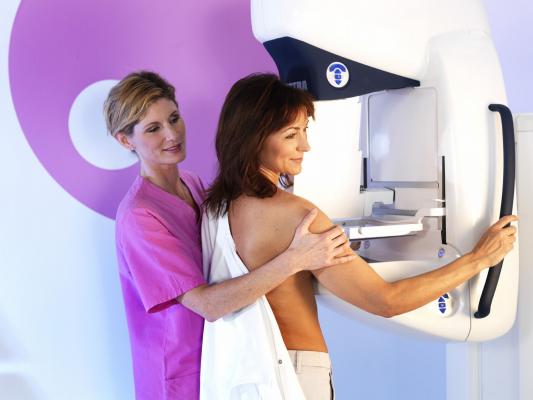
April 8, 2016 — Wide variability exists in radiation treatment decisions following neoadjuvant chemotherapy (NAC) and surgery for breast cancer, according to a review of the American College of Surgeons Oncology Group (ACOSOG) Z1071 prospective trial. ACOSOG is now part of the Alliance for Clinical Trials in Oncology.
A multi-center phase II trial, ACOSOG Z1071 evaluated the false negative rate of sentinel lymph node (SLN) surgery after NAC (chemotherapy delivered prior to treatment to shrink the tumor) in 701 breast cancer patients with initial node-positive disease who met all eligibility requirements; all eligible patients also underwent SLN surgery followed by completion axillary lymph node dissection (ALND). Six hundred eighty-five (685) patients enrolled in Z1071 were eligible for the current analysis, which sought to evaluate the variability of practice patterns following NAC.
The study, “Patterns of Local-Regional Management Following Neoadjuvant Chemotherapy in Breast Cancer: Results From ACOSOG Z1071 (Alliance),” was published in the March edition of International Journal of Radiation Oncology • Biology • Physics (Red Journal). Study authors focused primarily on surgical approaches, use of reconstruction after mastectomy, and use of post-mastectomy and regional nodal irradiation, nodal status and response to NAC.
After receiving chemotherapy, 401 (58.5 percent) patients remained node-positive while 284 (41.5 percent) changed to node-negative. Of 401 node-positive patients, mastectomy was performed in 148 (36.9 percent), mastectomy with immediate reconstruction in 107 (26.7 percent) and breast-conserving surgery (BCS) in 146 patients (36.4 percent). In women undergoing reconstruction, bilateral mastectomy rates were higher than in those who did not have reconstruction (66.5 percent versus 32.2 percent, respectively, P<.0001).
Most patients received RT, regardless of the surgical treatment of the primary tumor following NAC. Post-mastectomy RT was more frequently omitted after reconstruction than mastectomy (23.9 percent vs 12.1 percent, respectively, P=.002) and was omitted in 19 of 107 patients (17.8 percent) with residual node-positive disease in the reconstruction group.
The use of internal mammary RT was low, between 7.8 percent and 11.2 percent, and did not differ with surgical approaches. The rate for supraclavicular RT ranged from 46.6 percent to 52.2 percent, and was omitted in 193 node-positive patients (47.3 percent). Some of the observed variations reflect ongoing unresolved controversies in the field of radiation therapy.
In patients who converted to node-negative following NAC, and were treated with breast conserving surgery and radiation, regional nodal radiation was employed in approximately half the patients and omitted in half, reflecting the need for more guidance, an issue that is currently being addressed in a randomized national trial, NRG-B51.
“Patient and physician treatment decisions have been impacted by the increasing use of NAC,” said Bruce G. Haffty, M.D., interim director Rutgers Cancer Institute of New Jersey and department chair of Radiation Oncology, Rutgers Robert Wood Johnson Medical School, New Brunswick, New Jersey, lead author of the study. Haffty is also immediate past chair of the American Society for Radiation Oncology (ASTRO). “This study revealed wide variability in practice, particularly regarding administration of radiation therapy and field design following NAC and surgery for breast cancer.”
“Discussion and collaboration among all of the members of a multidisciplinary team of medical oncologists, surgical oncologists and radiation oncologists is important for optimal management,” Haffty said. “Patients should be made aware that there are various approaches to local-regional management of breast cancer after neoadjuvant systemic therapy.”
“The study also emphasizes the importance of the ongoing national clinical trials regarding local-regional management of breast cancer after NAC,” he said. “Specifically, the NRG B51 trial and the Alliance A011202 trial both address important aspects of local-regional treatment and will help to provide guidance on how to best approach local-regional management after neoadjuvant chemotherapy.”
For more information: www.redjournal.org


 April 17, 2024
April 17, 2024 








